The robotic rehab tools market is projected to grow from USD 551.3 million in 2025 to approximately USD 1,168.4 million by 2035, recording an absolute increase of USD 617.1 million over the forecast period. This translates into a total growth of 112.0%, with the market forecast to expand at a compound annual growth rate (CAGR) of 7.8% between 2025 and 2035. The overall market size is expected to grow by nearly 2.1X during the same period, supported by increasing prevalence of neurological disorders, rising demand for advanced rehabilitation solutions, and growing focus on patient mobility restoration technologies.
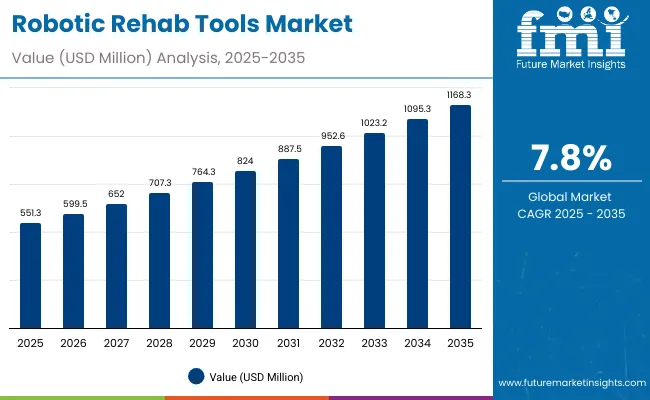
Robotic Rehab Tools Market Key Takeaways
| Metric | Value |
|---|---|
| Estimated Value in (2025E) | USD 551.3 million |
| Forecast Value in (2035F) | USD 1,168.4 million |
| Forecast CAGR (2025 to 2035) | 7.8% |
Between 2025 and 2030, the robotic rehab tools market is projected to expand from USD 551.3 million to USD 802.6 million, resulting in a value increase of USD 251.3 million, which represents 40.7% of the total forecast growth for the decade. This phase of growth will be shaped by rising awareness about robotic rehabilitation benefits, increasing demand for personalized therapy approaches, and growing penetration of robotic technologies in emerging healthcare markets. Healthcare providers are expanding their robotic rehabilitation capabilities to address the growing demand for effective mobility restoration solutions for neurological and musculoskeletal conditions.
From 2030 to 2035, the market is forecast to grow from USD 802.6 million to USD 1,168.4 million, adding another USD 365.8 million, which constitutes 59.3% of the overall ten-year expansion. This period is expected to be characterized by expansion of specialized rehabilitation centers, integration of artificial intelligence with robotic therapy systems, and development of personalized treatment protocols. The growing adoption of evidence-based rehabilitation medicine and healthcare provider recommendations will drive demand for clinically proven robotic rehab tools with enhanced efficacy and patient safety profiles.
Between 2020 and 2025, the robotic rehab tools market experienced significant expansion, driven by increasing recognition of neurological rehabilitation needs and growing acceptance of robotic-assisted therapy approaches. The market developed as healthcare providers recognized the need for advanced therapeutic solutions to address complex mobility and motor function disorders. Clinical research and regulatory approvals began emphasizing the importance of robotic technologies in achieving better patient outcomes for challenging rehabilitation conditions.
Market expansion is being supported by the increasing prevalence of neurological disorders and the corresponding demand for more effective rehabilitation approaches. Modern healthcare providers are increasingly focused on robotic technologies that can provide consistent therapy delivery, improve patient outcomes, and reduce the burden of manual therapy interventions. The proven efficacy of robotic rehab tools in treating conditions like stroke, spinal cord injuries, and neuromuscular disorders makes them essential components of comprehensive rehabilitation treatment plans.
The growing emphasis on personalized medicine and precision rehabilitation is driving demand for tailored robotic therapy systems that address individual patient needs and functional capabilities. Healthcare provider preference for automated rehabilitation solutions that combine multiple therapeutic modalities in sophisticated platforms is creating opportunities for innovative technology development. The rising influence of clinical guidelines and evidence-based treatment protocols is also contributing to increased adoption of proven robotic rehabilitation technologies across different patient populations and therapeutic areas.
The market is segmented by tool type, extremity, robotic structure, end user, and region. By tool type, the market is divided into exoskeletons, therapeutic robots, assistive robots, prosthetics & orthotics, and others. Based on extremity, the market is categorized into upper extremity, lower extremity, and full body applications. In terms of robotic structure, the market is segmented into end-effector robots and exoskeleton robots. By end user, the market is divided into hospitals, specialty clinics, senior care settings, and home care settings. Regionally, the market is divided into North America, Europe, East Asia, South Asia & Pacific, Latin America, and Middle East & Africa.
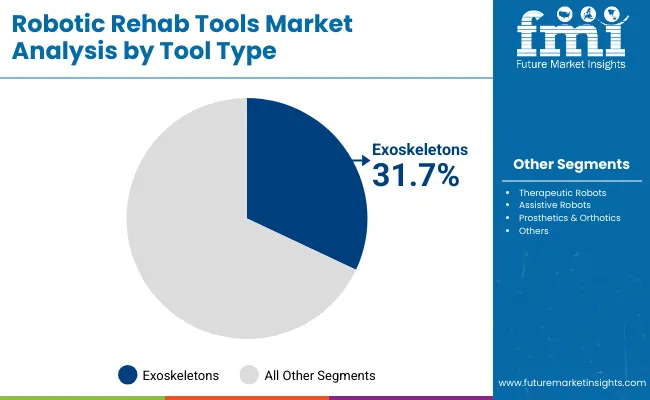
The exoskeletons segment is projected to account for 31.7% of the robotic rehab tools market in 2025, reaffirming its position as the category's dominant tool type. Healthcare providers increasingly recognize the comprehensive benefits of exoskeleton technologies for mobility restoration, gait training, and functional movement rehabilitation in patients with neurological and musculoskeletal conditions. This tool type addresses core rehabilitation needs and provides essential support for patients recovering from stroke, spinal cord injuries, and other mobility-limiting conditions.
This tool type forms the foundation of most advanced rehabilitation protocols, as it represents the most clinically validated and widely accepted robotic approach in physical therapy. Regulatory approvals and extensive clinical research continue to strengthen confidence in these rehabilitation technologies. With increasing recognition of the complexity of neurological rehabilitation requiring comprehensive mobility support, exoskeletons align with both acute rehabilitation and long-term functional improvement goals. Their broad therapeutic utility across multiple conditions ensures sustained market dominance, making them the central growth driver of robotic rehabilitation demand.
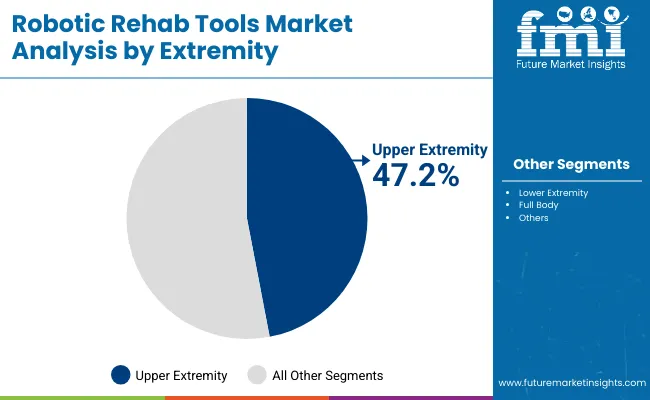
Upper extremity applications are projected to represent 47.2% of robotic rehab tools demand in 2025, underscoring their role as the primary focus driving rehabilitation technology adoption. Healthcare providers recognize that upper extremity rehabilitation for conditions like stroke, traumatic brain injury, and spinal cord injuries requires sophisticated robotic technologies that traditional therapy methods cannot adequately address. Robotic systems offer enhanced precision in movement training, motor function restoration, and functional skill development.
The segment is supported by the critical nature of upper extremity function for daily living activities and the growing recognition that robotic approaches can improve patient compliance and functional outcomes. Additionally, healthcare systems are increasingly adopting evidence-based rehabilitation guidelines that recommend specific robotic technologies for optimal upper extremity recovery. As clinical understanding of neuroplasticity and motor learning advances, upper extremity robotic rehabilitation will continue to play a crucial role in comprehensive therapy strategies, reinforcing their essential position within the robotic rehab tools market.
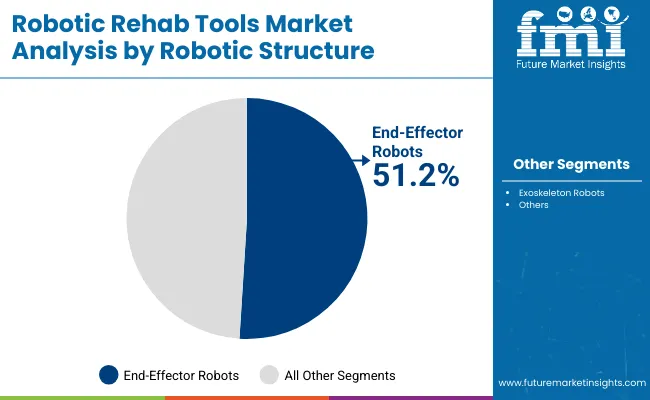
The end-effector robots structure is forecasted to contribute 51.2% of the robotic rehab tools market in 2025, reflecting the primary role of these systems in precise therapeutic movement control and rehabilitation training. Patients undergoing neurological rehabilitation rely on end-effector systems for targeted movement therapy, making these robots the cornerstone of advanced rehabilitation technology delivery. This structure provides essential capabilities including precise force control, movement guidance, and real-time feedback for optimal therapy outcomes.
The segment benefits from established clinical protocols and proven therapeutic effectiveness in motor function restoration. End-effector robots also offer advantages in terms of treatment precision, adaptability to different patient conditions, and integration with assessment technologies. With growing emphasis on evidence-based rehabilitation and patient-centered therapy services, end-effector robots serve as critical therapeutic tools for robotic rehabilitation, making them fundamental drivers of market accessibility and clinical adoption.
The hospitals channel is forecasted to contribute 47.5% of the robotic rehab tools market in 2025, reflecting the primary role of medical institutions in advanced rehabilitation services and patient care. Patients with complex neurological and musculoskeletal conditions rely on hospital-based rehabilitation programs for sophisticated robotic therapy, making hospitals the cornerstone of robotic rehab tool utilization. This channel provides essential services including comprehensive rehabilitation programs, multidisciplinary care teams, and coordination with medical treatment protocols.
The segment benefits from established clinical expertise and comprehensive rehabilitation capabilities that hospitals provide. Medical institutions also offer advantages in terms of clinical research participation, technology integration, and access to specialized rehabilitation professionals. With growing emphasis on comprehensive rehabilitation medicine and patient-centered care services, hospitals serve as critical deployment points for robotic rehab tools, making them fundamental drivers of market accessibility and clinical advancement.
The robotic rehab tools market is advancing rapidly due to increasing recognition of neurological rehabilitation needs and growing demand for advanced therapeutic approaches. However, the market faces challenges including high technology costs, complex training requirements, and concerns about technology integration with existing therapy protocols. Innovation in robotic control systems and artificial intelligence technologies continue to influence product development and market expansion patterns.
Expansion of Specialty Rehabilitation Centers and Advanced Therapy Facilities
The growing adoption of specialized rehabilitation centers is enabling more sophisticated robotic therapy delivery and patient management. Specialty facilities offer comprehensive robotic rehabilitation services, including technology training, therapy protocol optimization, and outcome monitoring, that are particularly important for complex neurological conditions. Advanced therapy centers provide access to rehabilitation specialists who can optimize robotic technology utilization and treatment protocols.
Integration of Artificial Intelligence and Adaptive Control Systems
Modern rehabilitation companies are incorporating artificial intelligence technologies such as adaptive therapy algorithms, real-time movement analysis systems, and personalized therapy progression to enhance robotic rehabilitation capabilities. These technologies improve therapy effectiveness, enable real-time performance assessment, and provide better coordination between robotic systems and therapy goals. Advanced AI platforms also enable personalized rehabilitation protocols and early identification of functional improvement opportunities or therapy optimization needs.
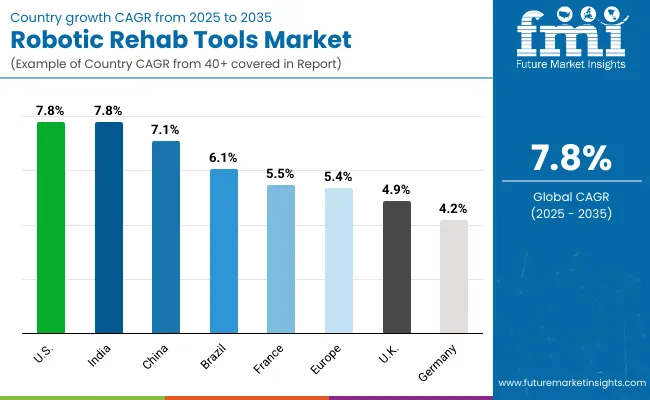
| Country | CAGR (2025 to 2035) |
|---|---|
| USA | 7.8% |
| India | 7.8% |
| China | 7.1% |
| Brazil | 6.1% |
| France | 5.5% |
| UK | 4.9% |
| Germany | 4.2% |
The robotic rehab tools market is experiencing strong growth globally, with the USA and India both leading at a 7.8% CAGR through 2035, driven by expanding rehabilitation infrastructure, increasing neurological disorder prevalence, and growing access to advanced robotic technologies. China follows at 7.1%, supported by healthcare system modernization, increasing recognition of rehabilitation medicine importance, and expanding robotic technology adoption. Brazil shows growth at 6.1%, emphasizing improved access to advanced rehabilitation services and robotic technology adoption. Europe records 5.4% growth, focusing on evidence-based rehabilitation protocols and comprehensive neurological care systems. Germany shows 4.2% growth, representing a mature market with established rehabilitation patterns and regulatory frameworks.
The report covers an in-depth analysis of 40+ countries; seven top-performing countries are highlighted below.
Revenue from robotic rehab tools in China is projected to exhibit strong growth with a CAGR of 7.1% through 2035, driven by ongoing healthcare system modernization and increasing recognition of rehabilitation medicine as a priority healthcare service. The country's expanding rehabilitation infrastructure and growing availability of specialized therapy services are creating significant opportunities for robotic technology adoption. Major international and domestic technology companies are establishing comprehensive distribution networks to serve the growing population of patients requiring advanced rehabilitation across urban and developing regions.
Revenue from robotic rehab tools in India is expanding at a CAGR of 7.8%, supported by increasing healthcare accessibility, growing neurological disorder awareness, and expanding rehabilitation technology market presence. The country's large patient population and increasing recognition of advanced rehabilitation approaches are driving demand for effective robotic therapy solutions. International technology companies and domestic manufacturers are establishing distribution channels to serve the growing demand for quality rehabilitation technologies.
Demand for robotic rehab tools in the USA is projected to grow at a CAGR of 7.8%, supported by well-established rehabilitation systems and evidence-based therapy guidelines. American healthcare providers consistently utilize robotic technologies for neurological rehabilitation and mobility restoration applications. The market is characterized by mature therapy protocols, comprehensive insurance coverage, and established relationships between healthcare providers and technology companies.
Revenue from robotic rehab tools in Brazil is projected to grow at a CAGR of 6.1% through 2035, driven by healthcare system development, increasing access to specialized rehabilitation services, and growing recognition of advanced therapy importance. Brazilian healthcare providers are increasingly adopting robotic technology approaches for complex neurological conditions, supported by expanding technology market presence and improved rehabilitation accessibility.
Revenue from robotic rehab tools in the UK is projected to grow at a CAGR of 4.9% through 2035, supported by the National Health Service framework and comprehensive evidence-based rehabilitation guidelines that facilitate appropriate use of robotic technologies for neurological rehabilitation. British healthcare providers consistently utilize established protocols for robotic technology management, emphasizing patient outcomes and therapy optimization within integrated care systems.
Revenue from robotic rehab tools in Germany is projected to grow at a CAGR of 4.2% through 2035, supported by the country's well-established rehabilitation infrastructure, comprehensive healthcare coverage, and systematic approach to neurological therapy. German healthcare providers emphasize evidence-based robotic technology utilization within structured healthcare frameworks that prioritize clinical effectiveness and patient safety.
Revenue from robotic rehab tools in France is projected to grow at a CAGR of 5.5% through 2035, supported by the country's comprehensive healthcare system, established rehabilitation infrastructure, and systematic approach to neurological therapy. French healthcare providers emphasize evidence-based robotic technology utilization within integrated care frameworks that prioritize patient outcomes and therapy continuity.
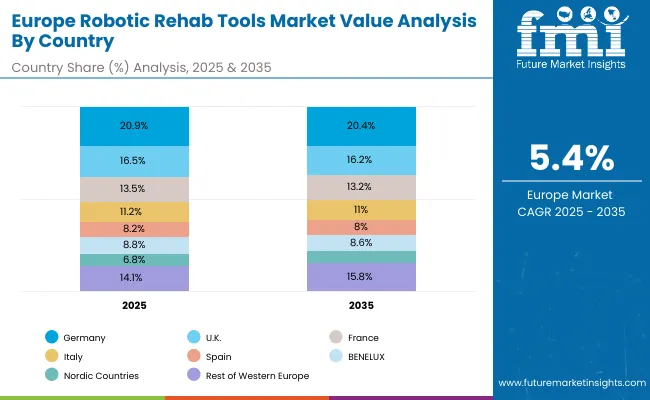
The robotic rehab tools market in Europe is projected to expand significantly through 2035, supported by increasing adoption of advanced rehabilitation technologies, rising prevalence of neurological disorders, and ongoing clinical innovation in robotic therapy systems. Germany will continue to lead the regional market, accounting for 20.9% in 2025 and declining slightly to 20.4% by 2035, supported by a strong clinical research base, reimbursement pathways, and robust rehabilitation infrastructure. The United Kingdom follows with 16.5% in 2025, decreasing to 16.2% by 2035, driven by NHS adoption of advanced rehabilitation guidelines, technology integration, and expanding specialist networks.
France holds 13.5% in 2025, declining to 13.2% by 2035 as other markets expand robotic technology adoption and demand grows for personalized rehabilitation solutions. Italy contributes 11.2% in 2025, decreasing to 11.0% by 2035, supported by regional rehabilitation programs and growing clinical research participation. Spain represents 8.2% in 2025, declining to 8.0% by 2035, underpinned by strengthening access to rehabilitation services and therapy technology programs.
BENELUX markets together account for 8.8% in 2025, moving to 8.6% by 2035, supported by innovation-friendly regulatory frameworks and academic-industry collaboration. The Nordic countries represent 6.8% in 2025, declining to 6.7% by 2035, with demand fueled by progressive healthcare systems and early adoption of evidence-based rehabilitation technologies. The Rest of Western Europe increases from 14.1% in 2025 to 15.8% by 2035, as emerging markets capture greater share of investment, clinical trials, and adoption of robotic rehabilitation protocols.
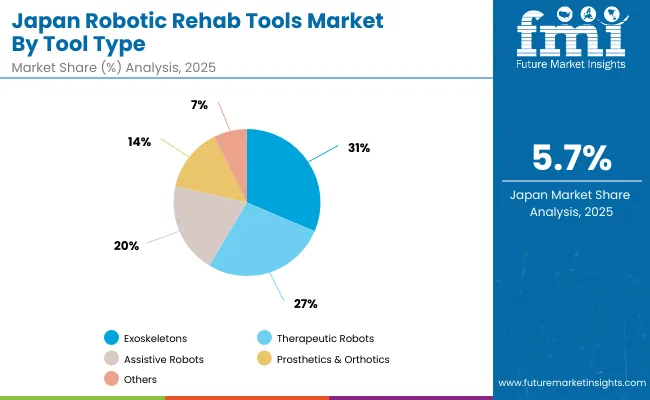
The robotic rehab tools market in Japan is set to remain diversified across several tool types in 2025, reflecting clinical preferences in rehabilitation practice and evolving therapy patterns. Exoskeletons dominate with a 31.4% share in 2025, supported by their central role in mobility restoration, gait training, and neurological rehabilitation within healthcare facilities.
Therapeutic Robots represent 27.2% in 2025, gaining traction from clinical applications targeting motor function recovery and functional movement training. Assistive Robots hold 20.0%, sustained by their widespread use for daily living support and independent function enhancement.
Meanwhile, Prosthetics & Orthotics account for 14.0%, driven by advanced biomechanical applications and comprehensive limb replacement solutions. Others contribute 7.4%, largely representing emerging robotic technologies and specialized rehabilitation devices. This distribution reflects the growing role of comprehensive rehabilitation approaches and advanced therapeutic technologies entering clinical practice in Japanese healthcare systems.
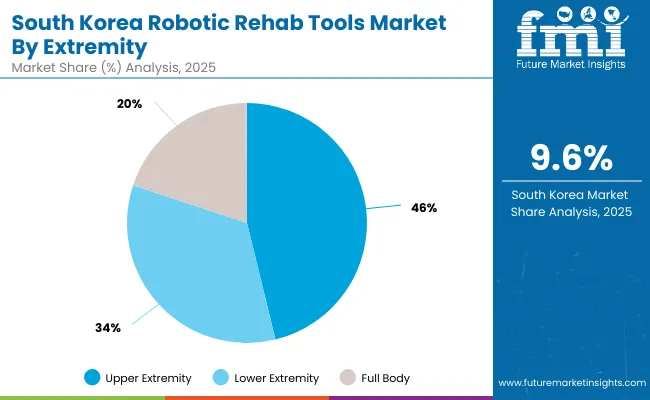
The robotic rehab tools market in South Korea in 2025 is shaped by strong demand across core extremity applications, reflecting both clinical prevalence and rehabilitation guidelines. Upper Extremity applications account for the largest share at 46.2%, supported by high rates of stroke rehabilitation, motor function recovery needs, and increasing integration of robotic technologies to address upper limb movement disorders.
Lower Extremity follows with 33.9%, driven by the rising demand for gait training solutions, mobility restoration awareness, and wider adoption of advanced robotic walking assistance protocols. Full Body applications contribute 19.9%, supported by the established use of comprehensive rehabilitation systems for complete mobility restoration and growing integration of full-body robotic technologies with therapeutic protocols.
This distribution reflects the growing emphasis on comprehensive rehabilitation and the expanding role of robotic technologies in both targeted and whole-body therapeutic applications within South Korea's healthcare system.
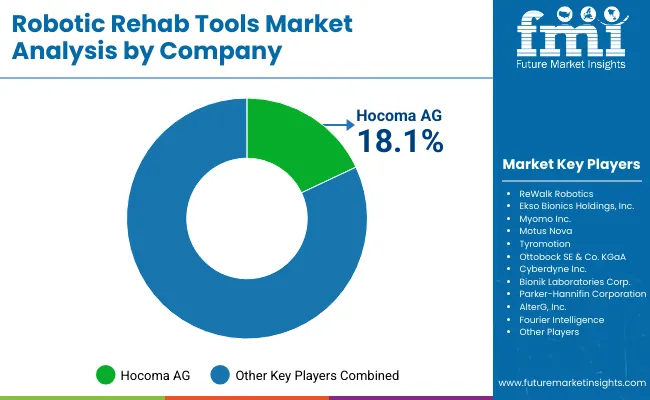
The robotic rehab tools market is characterized by competition among established medical technology companies, specialized robotics manufacturers, and rehabilitation technology focused firms. Companies are investing in robotic innovation, artificial intelligence integration, regulatory compliance, and clinical partnerships to deliver effective, safe, and accessible rehabilitation solutions. Technology development, clinical validation, and market access strategies are central to strengthening product portfolios and market presence.
Hocoma AG leads the market with 18.1% global value share, offering clinically-proven robotic rehabilitation technologies with a focus on neurological recovery and functional restoration. Other players collectively account for 81.9% market share, including ReWalk Robotics, which provides comprehensive exoskeleton technologies with emphasis on spinal cord injury rehabilitation. Ekso Bionics Holdings Inc. focuses on innovative exoskeleton systems and mobility restoration technologies. Myomo Inc. delivers specialized upper extremity robotic devices with strong clinical evidence and healthcare provider acceptance.
Motus Nova operates with focus on bringing innovative rehabilitation robotics to stroke and neurological recovery markets. Tyromotion provides comprehensive robotic therapy portfolios including devices across multiple rehabilitation applications. Ottobock SE & Co. KGaA specializes in prosthetics and robotic mobility solutions for comprehensive rehabilitation. Cyberdyne Inc., Bionik Laboratories Corp., Parker Hannifin Corporation, AlterG Inc., Fourier Intelligence, Kinova, Rehab-Robotics Co. Ltd., and MediTouch Ltd. provide specialized robotic technologies and innovative rehabilitation solutions to enhance market accessibility and patient access to essential therapy capabilities.
Robotic rehabilitation tools are emerging as transformative therapeutic technologies with strong applications in neurological recovery, mobility restoration, motor function training, and comprehensive physical therapy. The market's advantages - precise movement control, consistent therapy delivery, objective progress measurement, and enhanced patient engagement - make robotic rehab tools attractive to rehabilitation specialists, healthcare institutions, and patients seeking alternatives to traditional manual therapy approaches. Scaling robotic rehabilitation commercialization requires coordinated action across regulatory bodies, clinical standards organizations, technology innovators, healthcare delivery systems, and capital providers.
| Items | Values |
|---|---|
| Quantitative Units (2025) | USD 551.3 Million |
| Tool Type | Exoskeletons, Therapeutic Robots, Assistive Robots, Prosthetics & Orthotics, Others |
| Extremity | Upper Extremity, Lower Extremity, Full Body |
| Robotic Structure | End-Effector Robots, Exoskeleton Robots |
| End User | Hospitals, Specialty Clinics, Senior Care Settings, Home Care Settings |
| Regions Covered | North America, Europe, East Asia, South Asia & Pacific, Latin America, Middle East & Africa |
| Countries Covered | United States, Canada, United Kingdom, Germany, France, China, Japan, South Korea, India, Brazil, Australia and 40+ countries |
| Key Companies Profiled | Hocoma AG, ReWalk Robotics, Ekso Bionics Holdings Inc., Myomo Inc., Motus Nova, Tyromotion, Ottobock SE & Co. KGaA, Cyberdyne Inc., Bionik Laboratories Corp., Parker Hannifin Corporation, AlterG Inc., Fourier Intelligence, Kinova, Rehab-Robotics Co. Ltd., MediTouch Ltd. |
| Additional Attributes | Dollar sales by tool type and rehabilitation application, regional demand trends, competitive landscape, healthcare provider preferences for specific robotic technologies, integration with rehabilitation protocols, innovations in adaptive control systems, patient outcome monitoring, and clinical effectiveness optimization |
The market is valued at USD 551.3 million in 2025 and is projected to reach USD 1,168.4 million by 2035, expanding at a CAGR of 7.8% over the forecast period.
Exoskeletons dominate the market with a 31.7% share in 2025, driven by their effectiveness in mobility restoration, gait training, and neurological rehabilitation.
The upper extremity segment accounts for 47.2% of the market in 2025, reflecting the growing need for advanced robotic solutions in stroke recovery and motor function rehabilitation.
North America, Europe, and Asia Pacific are the leading regions. The U.S. and India are projected to grow at a CAGR of 7.8% each, while China follows at 7.1%.
Prominent companies include Hocoma AG, ReWalk Robotics, Ekso Bionics Holdings Inc., Myomo Inc., Motus Nova, Tyromotion, Ottobock SE & Co. KGaA, Cyberdyne Inc., Bionik Laboratories Corp., Parker-Hannifin Corporation, and AlterG Inc.






Our Research Products

The "Full Research Suite" delivers actionable market intel, deep dives on markets or technologies, so clients act faster, cut risk, and unlock growth.

The Leaderboard benchmarks and ranks top vendors, classifying them as Established Leaders, Leading Challengers, or Disruptors & Challengers.

Locates where complements amplify value and substitutes erode it, forecasting net impact by horizon

We deliver granular, decision-grade intel: market sizing, 5-year forecasts, pricing, adoption, usage, revenue, and operational KPIs—plus competitor tracking, regulation, and value chains—across 60 countries broadly.

Spot the shifts before they hit your P&L. We track inflection points, adoption curves, pricing moves, and ecosystem plays to show where demand is heading, why it is changing, and what to do next across high-growth markets and disruptive tech

Real-time reads of user behavior. We track shifting priorities, perceptions of today’s and next-gen services, and provider experience, then pace how fast tech moves from trial to adoption, blending buyer, consumer, and channel inputs with social signals (#WhySwitch, #UX).

Partner with our analyst team to build a custom report designed around your business priorities. From analysing market trends to assessing competitors or crafting bespoke datasets, we tailor insights to your needs.
Supplier Intelligence
Discovery & Profiling
Capacity & Footprint
Performance & Risk
Compliance & Governance
Commercial Readiness
Who Supplies Whom
Scorecards & Shortlists
Playbooks & Docs
Category Intelligence
Definition & Scope
Demand & Use Cases
Cost Drivers
Market Structure
Supply Chain Map
Trade & Policy
Operating Norms
Deliverables
Buyer Intelligence
Account Basics
Spend & Scope
Procurement Model
Vendor Requirements
Terms & Policies
Entry Strategy
Pain Points & Triggers
Outputs
Pricing Analysis
Benchmarks
Trends
Should-Cost
Indexation
Landed Cost
Commercial Terms
Deliverables
Brand Analysis
Positioning & Value Prop
Share & Presence
Customer Evidence
Go-to-Market
Digital & Reputation
Compliance & Trust
KPIs & Gaps
Outputs
Full Research Suite comprises of:
Market outlook & trends analysis
Interviews & case studies
Strategic recommendations
Vendor profiles & capabilities analysis
5-year forecasts
8 regions and 60+ country-level data splits
Market segment data splits
12 months of continuous data updates
DELIVERED AS:
PDF EXCEL ONLINE
Robotic Warfare Market Size and Share Forecast Outlook 2025 to 2035
Robotic Lawn Mower Market Size and Share Forecast Outlook 2025 to 2035
Robotics Welding Market Size and Share Forecast Outlook 2025 to 2035
Robotics-Assisted Telesurgery Market Size and Share Forecast Outlook 2025 to 2035
Robotic Packaging Machines Market Size and Share Forecast Outlook 2025 to 2035
Robotic Assisted Endovascular Systems Market Size and Share Forecast Outlook 2025 to 2035
Robotic Lung Biopsy Market Size and Share Forecast Outlook 2025 to 2035
Robotics as a Service (RaaS) Market Size and Share Forecast Outlook 2025 to 2035
Robotic X-ray Scanner Market Size and Share Forecast Outlook 2025 to 2035
Robotic Catheterization Systems Market Growth – Innovations, Trends & Forecast 2025-2035
Robotic Aseptic Syringe Filler Capper Market Size and Share Forecast Outlook 2025 to 2035
Robotic Vision Market Size and Share Forecast Outlook 2025 to 2035
Robotics Actuators Market Size and Share Forecast Outlook 2025 to 2035
Robotic Biopsy Devices Market Insights - Trends & Forecast 2025 to 2035
Robotic Palletizers & De-Palletizers Market Growth - Forecast 2025 to 2035
Robotic Vacuum Cleaners Market Growth - Trends & Demand from 2025 to 2035
The Robotics Market Analysis – Size, Share, and Forecast Outlook 2025 to 2035
Robotics Prototyping Market Trends - Growth & Forecast 2025 to 2035
Robotic Process Automation Market by Component, Operation, Industry & Region Forecast till 2025 to 2035
Competitive Landscape of Robotic Vacuum Cleaner Providers

Thank you!
You will receive an email from our Business Development Manager. Please be sure to check your SPAM/JUNK folder too.
Chat With
MaRIA